Highlights from the 2017 Venice Biennale: 10 works to pay attention to
The fifty-seventh edition of the Venice Biennale, curated by Christine Macel, will open its doors to the public tomorrow, Saturday, May 13, 2017, and this year bears the title “Viva arte viva.” We have taken a sneak peek and offer ten works that we think you should pay attention to.
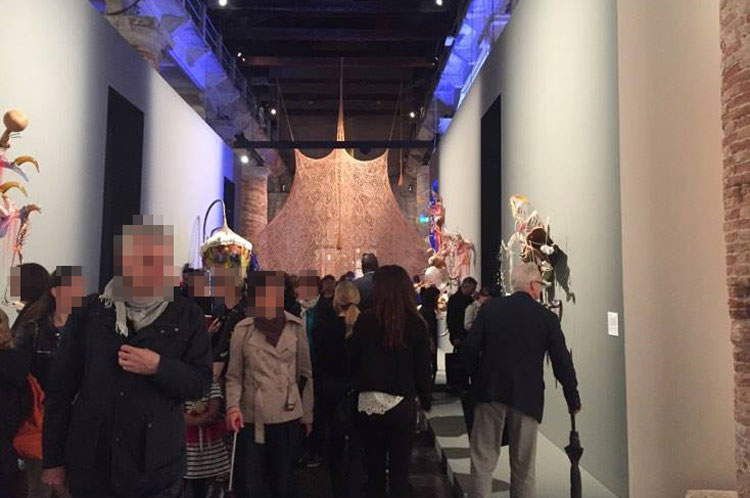 |
| Press preview of the 2017 Biennale. Ph. Credit: Federica Forti |
1. Liliana Porter, El hombre con el hacha y otras situaciones breves
Argentinian artist Liliana Porter (Buenos Aires, 1941) arrives at the 2017 Biennale with a new edition of an installation dating back to 2014, which is titled El hombre con el hacha y otras situaciones breves (“The man with the axe and other short situations”) and can be seen in the spaces of the Arsenale. A tiny little man wielding an axe is placed at the end of a series of broken objects: books, chairs, cups and ceramics, toys, model ships, even the carcass of a piano. All without any real proportions being respected: a ploy to induce the viewer to reflect on the relationship between reality and its representation (one of the themes of Liliana Porter’s research), or simply to make even more alienating a work that is deliberately ambiguous. We do not know, in fact, whether the little man with the axe is responsible for the destruction or wants to further haunt the shreds of a past that remains imprinted as memory but has been overwhelmed by the passage of time. Adding to this sense of estrangement are other figurines found all along the “path” traced by these ruins of the past: players, toy soldiers, simple passersby wander among the ruins prompting us to reflect even more on the meaning of the work in general and its individual details. Probably a work that speaks to us mainly about time, a concept that has often inspired Liliana Porter’s works.
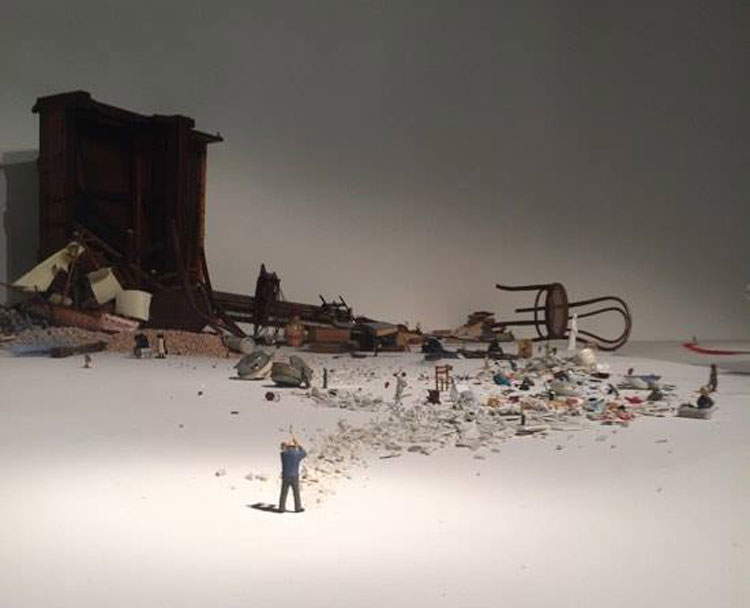 |
| Liliana Porter, El hombre con el hacha y otras situaciones breves (2017; mixed media installation, 170 x 950 x 650 cm; 57. Esposizione Internazionale dArte - La Biennale di Venezia, Viva Arte Viva). Ph. Credit: Federica Forti |
2. Ernesto Neto, Um sagrado lugar
The large installation Um sagrado lugar (“A Sacred Place”) by Brazilian Ernesto Neto (Rio de Janeiro, 1964), an old acquaintance of the Venice Biennale, is one of the most interesting works exhibited at the Arsenale. It is a kind of large tent decorated with geometric patterns, inside which the artist has arranged earth, sand, books and ceramic pots and which he has surrounded with pots of plants. A work inside which, moreover, visitors can sit and linger, becoming part of the installation themselves (the interaction between public and work is a typical feature of Ernesto Neto’s works). The tent is clearly inspired by those of the indigenous peoples of Brazil, in particular those of the Huni Kuin tribe, who live in the Amazon, in the territories bordering Peru: it is precisely the spirituality of the native land that this work of art looks to, all the more important if we think of the sad vicissitudes that the native peoples continue to endure (in these very days we are witnessing an escalation of violence against the indigenous peoples, who are asking for more consideration and protection from the government). Moreover, Ernesto Neto has brought with him to Venice some members of the Huni Kuin tribe who, also through performances, will participate in the opening of the Biennale.
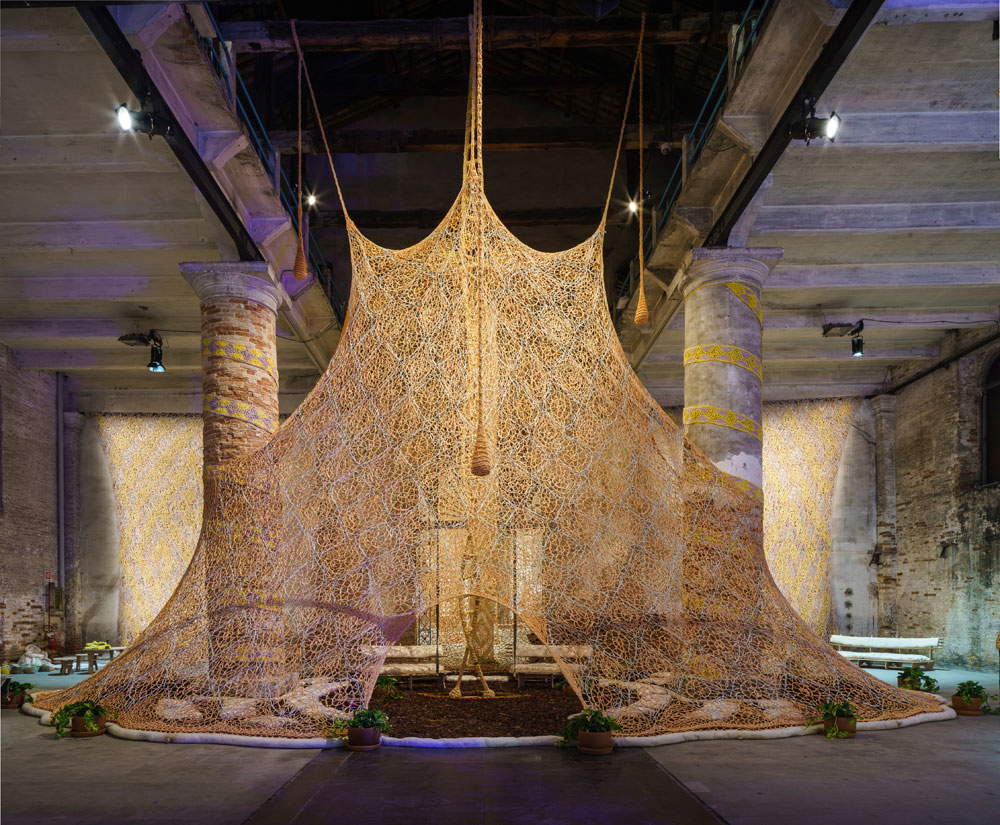 |
| Ernesto Neto, Um sagrado lugar (2017; crocheted cotton, wadding, voile, canvas, jute, voile knots, wood, plywood, water filter, earth, sand, tools, ceramic pots, plants, photography, Huni Kuin drawing, textiles, chants, Una Isi Kayawa book, fabric book; dimensions variable; 57. Esposizione Internazionale dArte - La Biennale di Venezia, Viva Arte Viva). Ph. Credit: Andrea Avezzù. Courtesy La Biennale di Venezia. |
3. Maria Lai, Stitched Books.
La Biennale 2017 pays homage to Maria Lai (Ulassai, 1919 Cardedu, 2013) by exhibiting some of her works executed between 1981 and 2008. These include some of her Libri cuciti: books in which words are “written” by threads arranged on their surface. Maria Lai is known for her art that reinterprets the ancient tradition of weaving and creates works made of threads, fabrics, and looms that take on ever-changing symbolic meanings. The thread she writes about in the book is a metaphor for the thread of history, for example, but it is also a reference to the ancient craft activities of the women of Sardinia, for whom weaving represented a moment of socialization and cultural sharing.
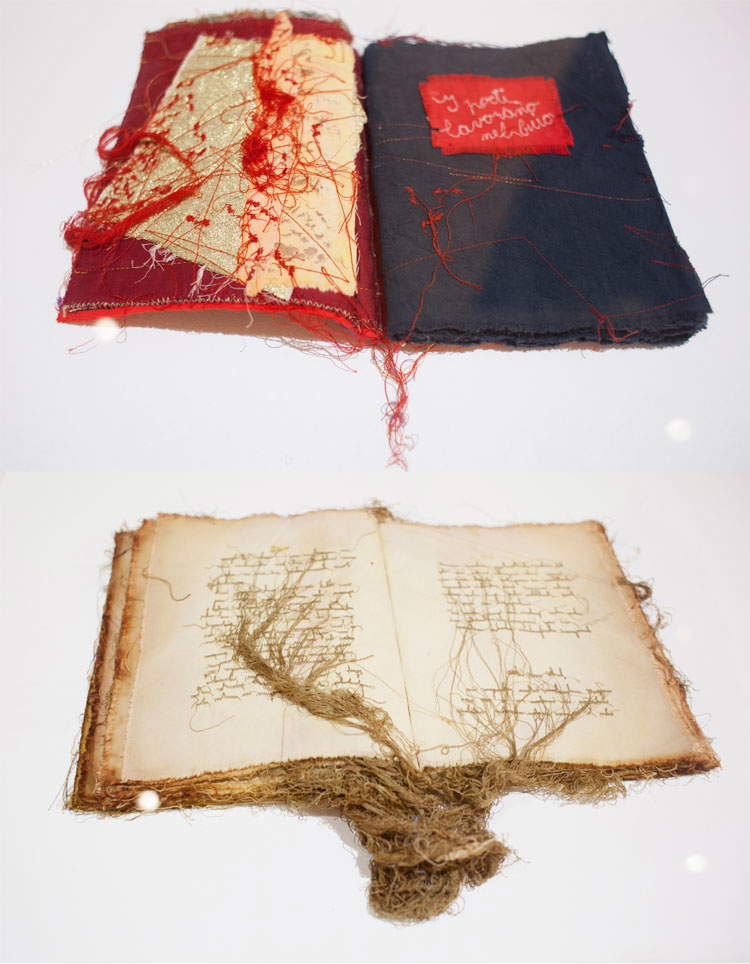 |
| Some of Maria Lai’s sewn books. Ph. Credit: Italo Rondinella. Courtesy La Biennale di Venezia. |
4. Katherine Nuñez & Issay Rodriguez, In between the lines 2.0.
The two youngest artists of the fifty-seventh edition of the Venice Biennale come from the Philippines: they are Katherine Nuñez (Manila, 1992) and Issay Rodriguez (Manila, 1991) who, also with the help of woolen threads and crochet (and this is not the only work in which the intertwined threads have no small weight), recreate a kind of student’s desk, as a child. The title is In between the lines 2.0 (“Between the lines 2.0”) and is located in the central pavilion of the Gardens. Here, too, the themes of education and craftsmanship (as well as craft education) return, and the playful image that emerges, one of the most positive of the Biennale, surprises and comforts: we see pencils and pens made of woven threads, notebooks and books, pillows to rest on. Children, after all, are “powerful beings,” as per the title of a 2014 work by Katherine Nuñez.
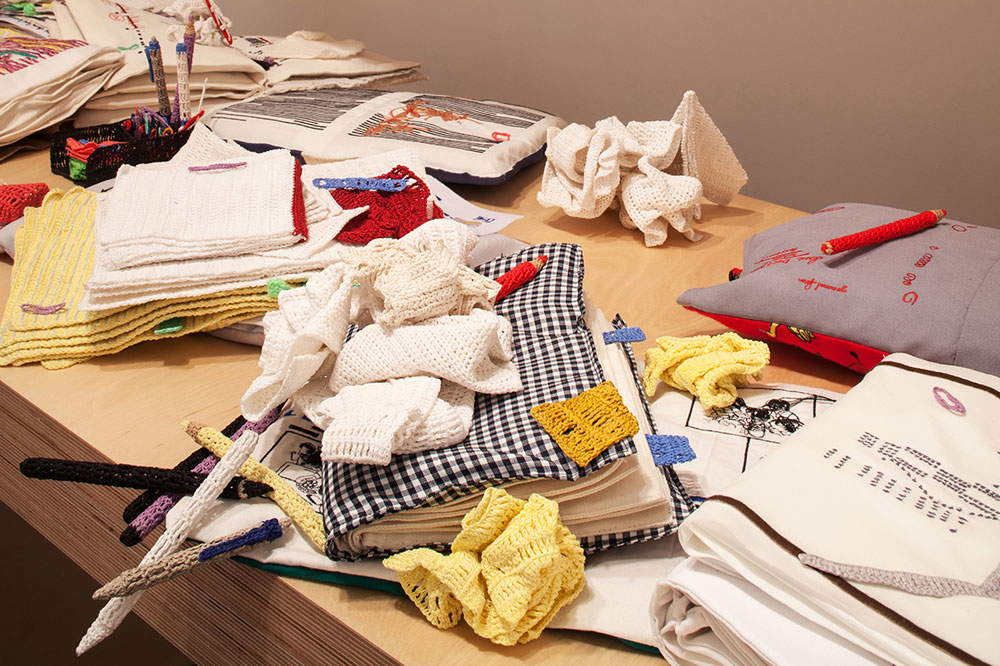 |
| Katherine Nuñez and Issay Rodriguez, In between the lines 2.0 (2015-2017; crochet, embroidery, sewing work; 57. Esposizione Internazionale dArte - La Biennale di Venezia, Viva Arte Viva). Ph. Credit: Francesco Galli. Courtesy La Biennale di Venezia. |
5. Hassan Sharif, Hassan Sharif Studio (Supermarket).
The Biennale pays tribute to Emirati artist Hassan Sharif (Dubai, 1951 - 2016) by bringing to the Giardini his Studio, a work that is the result of twenty-six years of work and certainly stands as one of the most scenic of the 2017 Biennale. It is a sort of supermarket aisle on whose shelves are piled (albeit in strict order) piles of junk and recycled waste: a not even too veiled critique of the society of consumerism, but perhaps also an indictment of thecontemporary art system, which is strongly market- and trade-oriented.
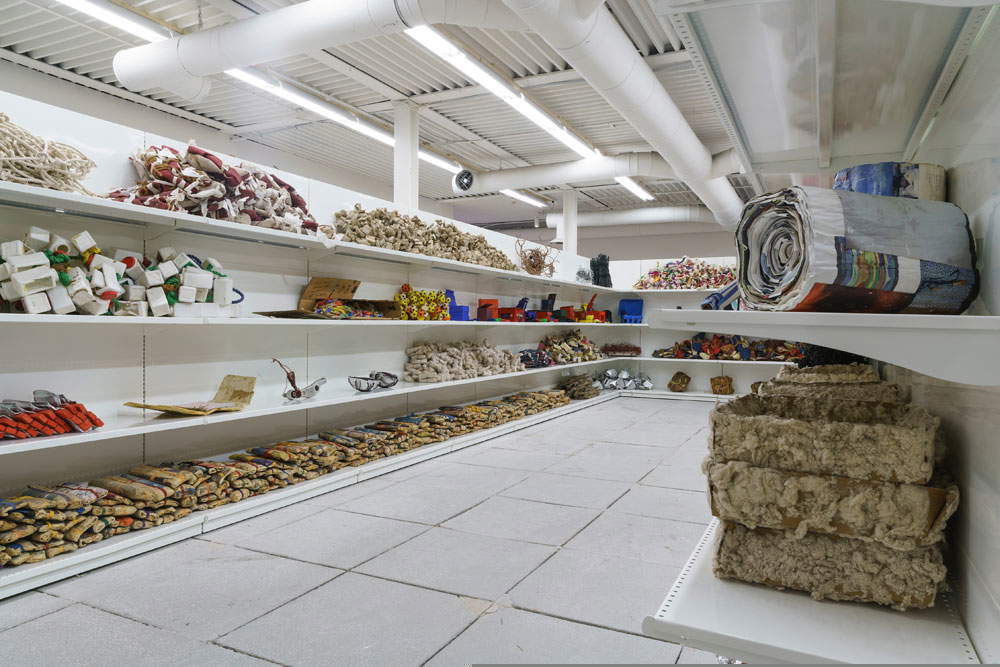 |
| Hassan Sharif, Hassan Sharif Studio (Supermarket) (1990-2016; objects, bags, books, boxes; dimensions variable; 57. Esposizione Internazionale dArte - La Biennale di Venezia, Viva Arte Viva). Ph. Credit: Andrea Avezzù. Courtesy La Biennale di Venezia. |
6. Frances Stark, Behold man!
The work that Frances Stark (Newport Beach, 1967) brings to the exhibition (located in the Giardini) is titled Behold man! (Behold man!) and is a kind of self-portrait in which the artist depicts herself, with a simple black outline and in the most total two-dimensionality, lying on a couch leaning against a wall enclosing a checkered floor seen in perspective. The woman looks in front of her, and we can tell what she is looking at if we look at mirror hanging higher up: we see reflected some people, including a naked man, standing in front of her. Scattered on the floor and hanging on the wall we see papers, magazines, photographs. Evident erotic references, not even too veiled: also present, on the small table in front of the sofa, a rooster (in English “cock” means, indeed, “rooster,” but it is also a term referring to the male genital organ).
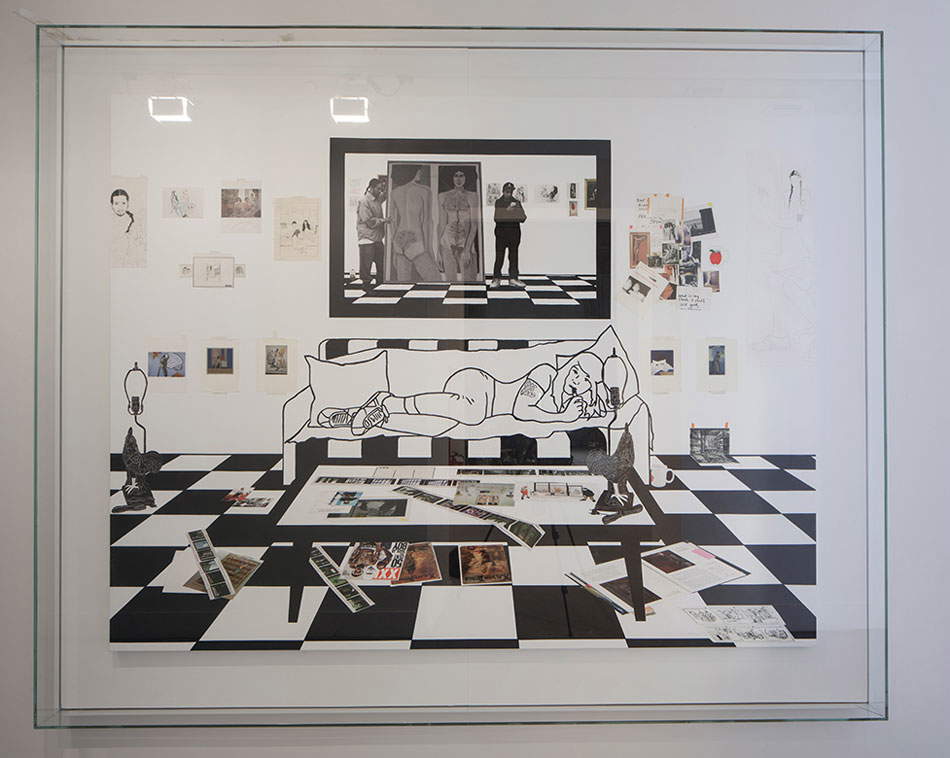 |
| Frances Stark, Behold Man! (2013; mixed media, ink print and painting, 191.8 x 244.2 x 3 cm; 57. Esposizione Internazionale dArte - La Biennale di Venezia, Viva Arte Viva). Ph. Credit: Francesco Galli. Courtesy La Biennale di Venezia. |
7. Olafur Eliasson, Green light. An artistic workshop
Olafur Eliasson (Copenhagen, 1967) is one of the biggest names of the 2017 Biennale and brings to Venice the project Green light. An artistic workshop (“Green light. An artistic workshop”), which the Danish artist dedicates to migrants and refugees by giving them a metaphorical green light of hope. The project will involve eighty asylum seekers housed in facilities in Venice, who will participate in his artistic workshop to create the green lamps and will therefore crowd the Giardini for the duration of the Biennale. The lamps they produce will be sold with a minimum bid of 250 euros, and the proceeds will go to projects of nongovernmental organizations. “The displacement of masses of people and migration,” said the artist, declaring himself honored to participate in the Biennale, "are the great challenges of today’s world: they affect millions of people from all over the planet. Green light is meant to be a modest strategy to channel the challenges and responsibilities that arise from the current situation and to shine a light on the value of collaborative work and thinking."
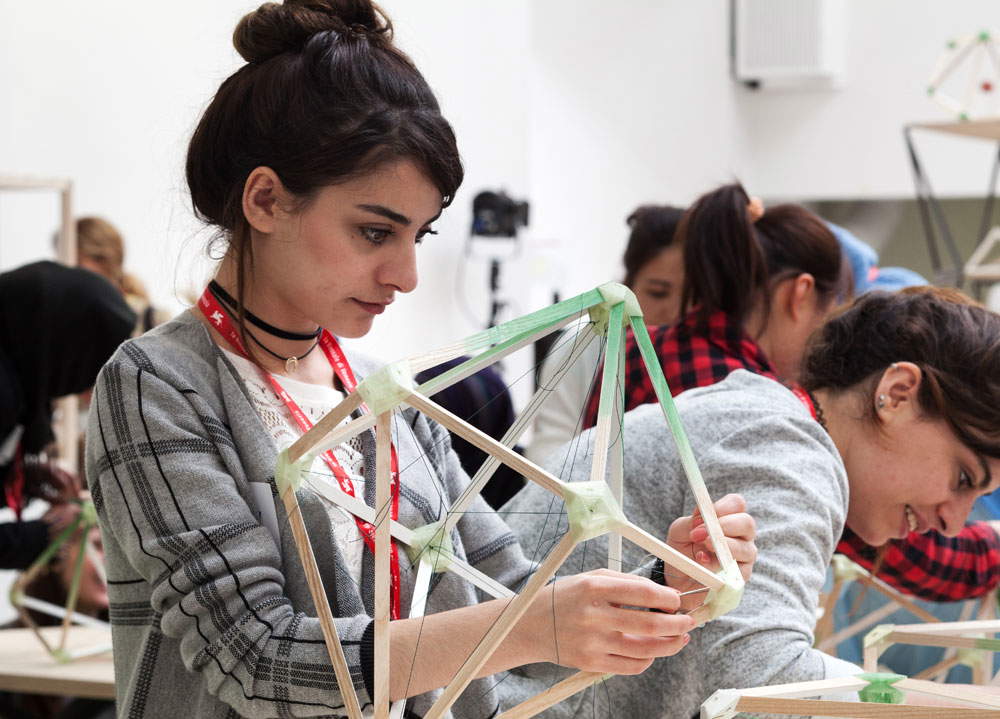 |
| Olafur Eliassion, Green light. An artistic workshop. Ph. Credit: Francesco Galli. Courtesy La Biennale di Venezia. |
8. Roberto Cuoghi, Imitation of Christ.
Three artists have been chosen this year for the Italian Pavilion (for which the title Il mondo magico (The Magic World), curated by Cecilia Alemani, has been chosen): among them is the Emilian Roberto Cuoghi (Modena, 1973), who returns to the Biennale by exhibiting the somber installation Imitazione di Cristo (Imitation of Christ). Taking inspiration from the medieval text of the same name, which invited the viewer to abandon worldly things and pursue a life inspired by the path of Jesus, Roberto Cuoghi proposes a series of “devotional figures” that result from a process of transformation of matter and are placed in a space reminiscent of a workshop within which these figures are created. A laboratory where some operators continuously create these strange sculptures, bodies that are first shaped and then subjected to a process that aims to obtain their decomposition. A continuous cycle of birth, death, and regeneration that creates images that are never the same (“producing a dissociation that seems to concern our present,” explains the curator) but above all of strong impact, such as those that in the past were meant to inspire mystical feelings in observers.
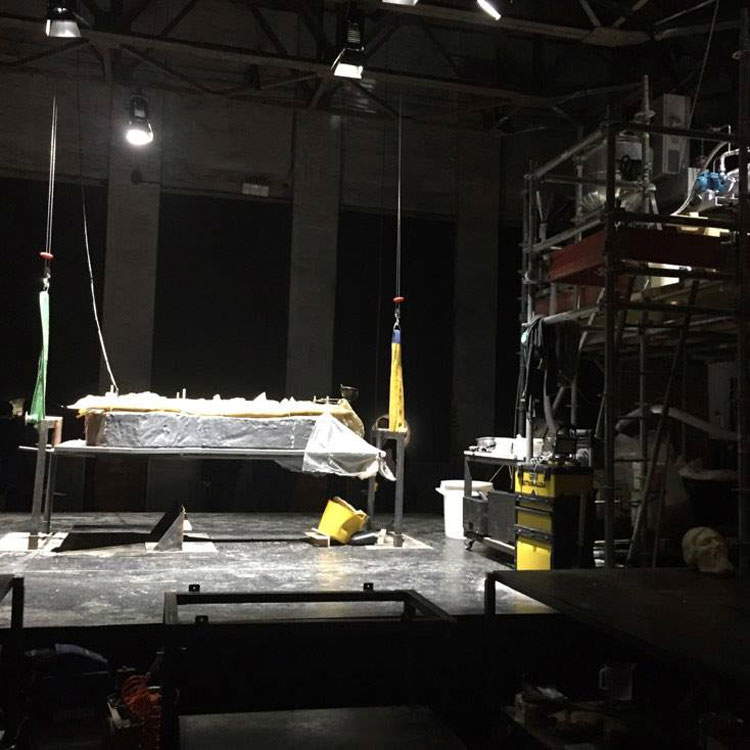 |
| Roberto Cuoghi, Imitation of Christ (2017). Ph. Credit: Federica Forti. |
9. Mark Bradford, Tomorrow is another day.
The installation that Mark Bradford (Los Angeles, 1961) conceived for the U.S. Pavilion (curated by Christopher Bedford and Katy Siegel) is titled Tomorrow is another day (“Tomorrow is another day”) and transforms the pavilion into a sort of cave that showcases, as the artist explains, his “interest in marginalized people, their vulnerability and resilience, and the continuing threat-hope cycle of America’s never-fulfilled social promises.” A work that comes at a very delicate moment in U.S. history and tells of “ruin, violence, action, possibility, ambition,” but also of “faith in art’s ability to engage us in urgent and profound conversations and perhaps even actions.” This narrative takes the form of a distressing abstract installation that assaults the space of the U.S. Pavilion, ruining and deteriorating it, and continues with the works, sometimes somber and sometimes open to a thread of hope, with which Bradford continues his own exhibition.
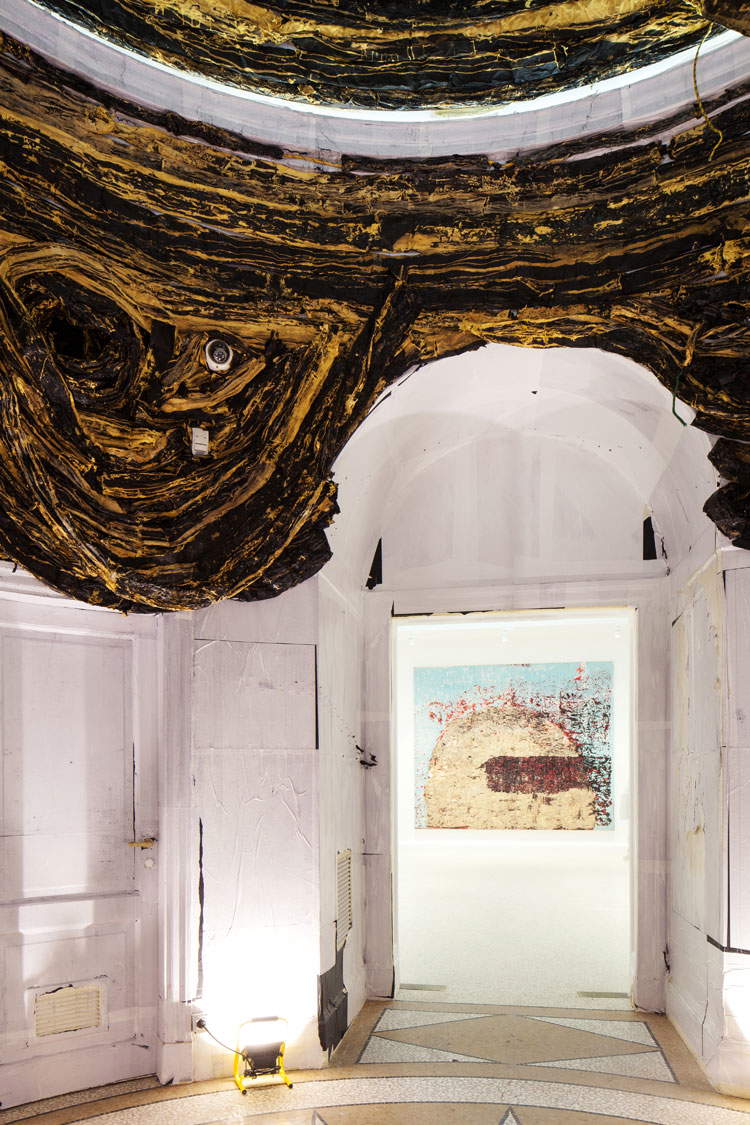 |
| Mark Bradford, Tomorrow is another day (2017). Ph. Credit: Francesco Galli. Courtesy La Biennale di Venezia. |
10. Xavier Veilhan, Venice Studio
Entrusted to one of the most interesting contemporary French artists, Xavier Veilhan (Lyon, 1963), the French Pavilion has been entirely transformed into animmersive work of art, entitled Studio Venezia. Through geometric elements made of wood and intersecting planes, typical of his stylistic signature, Veilhan creates an environment with a dreamlike atmosphere, vaguely surrealist but also Dada (the most immediate reference is Kurt Schwitters’ Merzbau, as the artist himself had the opportunity to explain), which for the duration of the Biennale will be a kind of recording studio, because it will host musicians from all over the world who will alternate with musical instruments making Studio Venezia a sound environment capable of merging different art forms: sculpture, architecture, painting, music.
 |
| Xavier Veilhan, Studio Venezia (2017). Ph. Credit: Francesco Galli. Courtesy La Biennale di Venezia. |
Warning: the translation into English of the original Italian article was created using automatic tools. We undertake to review all articles, but we do not guarantee the total absence of inaccuracies in the translation due to the program. You can find the original by clicking on the ITA button. If you find any mistake,please contact us.



























